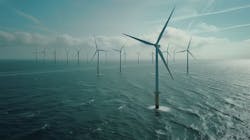Editor's note: This cover story first appeared in the July/August 2024 issue of Offshore magazine.
By David Paganie, Chief Editor
The US offshore wind industry is dealing with another setback in the wake of a turbine blade failure off Massachusetts. The incident occurred on July 13, with part of a 107-m- (351-ft) long blade breaking about 20 m (66 ft) out from its root, leaving debris in the water and washing up on Nantucket Island, offshore Massachusetts. The compromised turbine is part of the Vineyard Wind 1 offshore wind farm in a federal area about 35 mi (56 km) from mainland Massachusetts.
As of February, it had five turbines of the 62 planned operating at full capacity, capable of generating 68 megawatts (MW) of power. Full field capacity is expected to generate up to 800 MW of power. A number of investigations were underway at the time of this writing to determine the root cause of the incident. GE Vernova, the manufacturer and supplier of the turbine blades and installation contractor, claims its preliminary investigation indicates that the affected blade experienced a manufacturing deviation – in this case, insufficient bonding – that the quality assurance program should have identified. A company spokesperson added that there is no indication of an engineering design flaw in the blade or information connecting this incident to another blade event it experienced at an offshore wind project in the UK, which was caused by an installation error. The company plans to reinspect all 150 blades that were manufactured at the plant where the material deviation was identified.
Federal regulator BSEE has issued two suspension orders to the Vineyard Wind 1 project developments while it conducts its own investigation into the causes and factors that contributed to the incident. The orders called for a complete halt to development and production operations and the submittal of a risk analysis and any mitigation measures for personnel that will board a turbine.
While blade failures are understood to be very rare, this incident will raise concerns among other ocean stakeholders, regulatory authorities, and local communities about the safety and integrity of the industry. It is a particularly delicate situation for a nascent industry that is seeking to gain trust.
Fortunately, as of this date, there were no reported injuries or harm to any marine resources or mammals from the incident.
US offshore wind was just starting to regain momentum after a lull due to financial constraints and logistical challenges. The South Fork offshore wind farm off New York, the first commercial-scale offshore wind farm, delivered its first power to the state's grid this past December. In March, all 12 turbines were operational and expected to deliver up to 130 MW. A report from American Clean Power Association earlier this year suggested that three offshore projects were under construction and 37 more in development. The report added that there were 12 GW of projects with active offtake agreements.
Meanwhile, there is political uncertainty for offshore wind in the US as well, with a looming presidential election that could significantly change the growth trajectory of the market. For more on offshore wind development, see the 3rd annual Offshore Wind Special Report. It reviews the latest projects and technologies, contains executive insights, and much more.
About the Author
David Paganie
Energy Conference Director
After 20 years with Offshore, David Paganie has transitioned into a new role within Endeavor Business Media as Energy Conference Director, effective Jan. 1, 2025.
He is still leading the event content, chairing the conference advisory boards and working with the conference teams for Offshore's events (Subsea Tieback and Deepwater/Topsides) as well as Microgrid Knowledge's events. His success in growing event content and securing senior level executives as speakers has led to him creating many of the best practices at Endeavor.
Paganie previously served as Chief Editor of Offshore magazine and Conferences Editorial Director. He oversaw the Offshore portfolio of print and digital editorial content and international oil and gas conferences. He also wrote the monthly Comment column for Offshore.
He previously served as Editor of Offshore Field Development International at ODS-Petrodata; and as an Analyst at Baker Energy. He holds a Bachelor of Business Administration degree with a specialty in finance from Ohio University.

